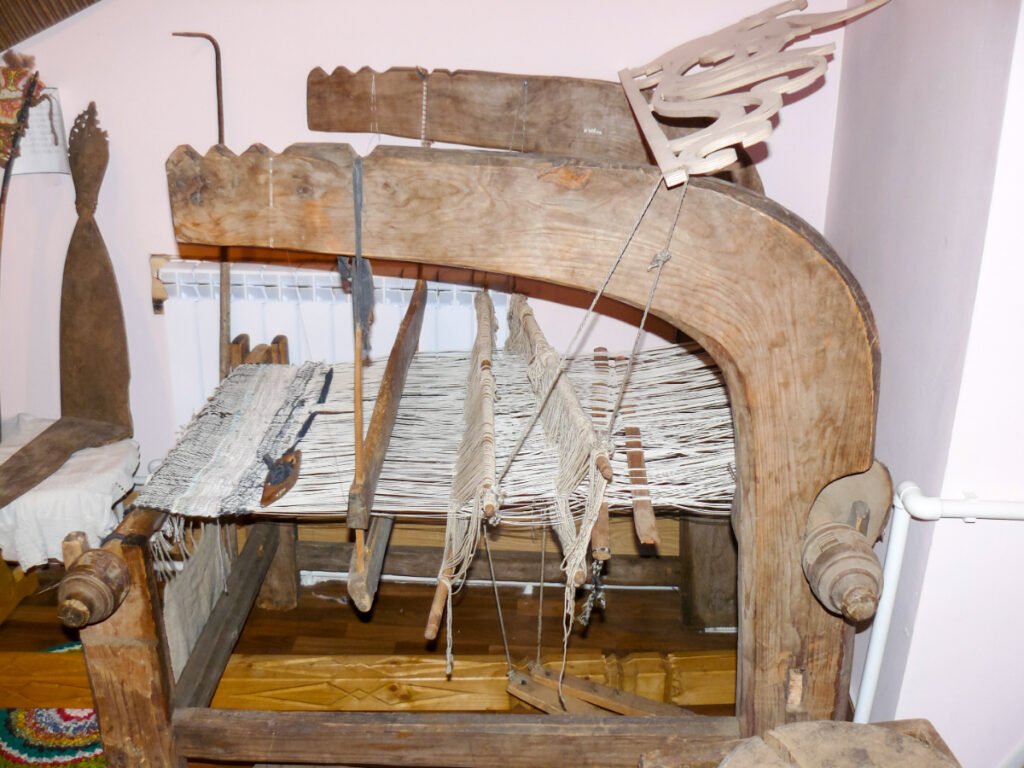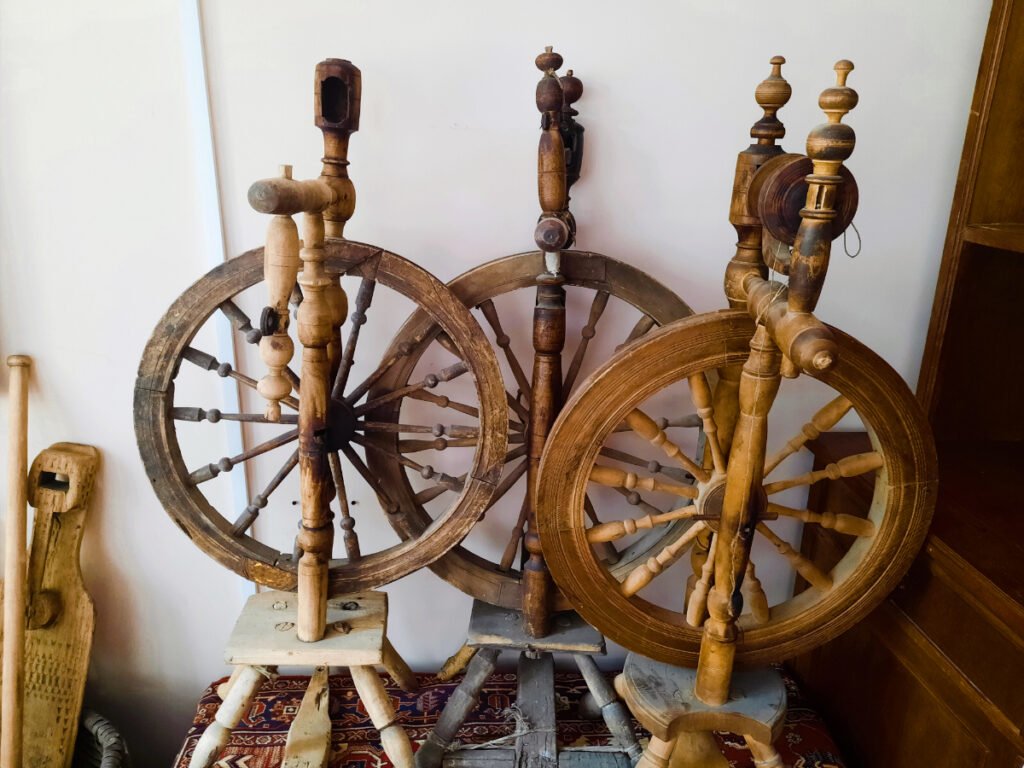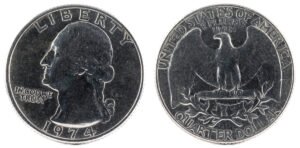You all might spend thousands on new clothes. But do you know that you can ‘get’ millions for the machine that made clothes back in ancient times? Well, ask your granny if she still has her old spinning wheel. If she lets you resell it, kudos! You are about to strike it rich!
But you don’t see a spinning wheel every day. So chances are that you might wonder if it’s old and worthy. So, today, I’ll help you spot and value vintage spinning wheels. So just read along and tick the features you see!
Key Takeaways
- Old spinning wheels with large drive wheels and leather bands are authentic and expensive. Also, check if it has flexible brakes, flyers, and bobbins for an old make.
- Get spinning wheels with hardwood, beech, or brass bodies for a durable finish. You can also pick Shellac or wax finishes for best returns.
- If you don’t want bare wood or metal finishes, pick brown, blue, or gold wheels. You can also explore Victorian or Dutch carvings for more patterns!
- Antique spinning wheels have six types based on design and size. Of these, the Great Wheel and Charkha are the most precious!
How Do You Check If Your Spinning Wheel Is Old & Antique?
Checking antique spinning wheels is just a matter of a few visual tests! But first, just take a tape and measure its wheel. If it’s 13 – 24 inches in diameter, it’s old and precious, costing up to $600. But, if it’s less than that, it might be cheap, costing $150 – 200.
But if you don’t have tape, look for the following features:
- Large drive wheels, pointed spikes, and drive bands to rotate the spindle
- Check if the leather drive band has adjusting tension or brakes
- Pick wheels with oval pedals and freely moving bobby pins and flyers
- Get 14 – 19-inch wheels with varying diameters and a symmetrical, hand-cut design
- See if the wheel’s wood has shellac, paint, or oil finish
How Did Antique Spinning Wheels Evolve?
Well, the origin of antique spinning wheels is still a matter of debate! Some say it’s from China, while others trace it to the Indus Valley. But what we know for sure is that these wheels date back to the 1270s. So, you’ll see crude hand joints and seals with them!
It was in the 1500s that Leonardo da Vinci painted a self-spinning yarn. And inspired by that, the Germans made an automatic spinner with pedals. So, if you see such a large, water-powdered spinner, you can price it up to $1200.
The next 1700s era was a bit tricky! Like, Lewis Paul and John Wyatt did add bobbins to roll the yarn. But, its use went down, and people moved to the new spinning machine instead. So, you’ll get these later models easily on a budget!
6 Types of Vintage Spinning Wheels & Their Value
Identifying the spinning wheel type is the first step to valuing it correctly! So, let’s check out different types of antique spinning wheels to estimate their base cost!
1. Great Spinning Wheel

The great wheel looks just like an old penny farthing! It just has a single 46-inch wheel and a spindle in place of the handle. You’ll also notice a hand-held brake and twister to hold the wool and cotton. Plus, these have long flyers and benches, costing $300 – 400.
2. Saxony Spinning Wheel
Saxony wheels are large, vertical spinning wheels with straight flyers and spindles. So, they allow the spinner to face the wheel and fit well in compact spaces too! Also, see if it has an inclined bench and axle. If yes, it costs $250 – 300. Otherwise, $150 – 200 is good.
3. Norwegian Spinning Wheel
Norwegian spinning wheels are thin, Scottish frames for delicate yarn. So, they are small and come with a flywheel and narrower bench. Plus, they have a flat bobbin and spindle for easy use.
But, these have high friction and wear with age, giving them a low cost of up to $160.
4. Charkha

Charkha, or cotton gin, means a fabric spinning reel in India. And since people turn these by hand, they are sturdy and polished! Charkhas also have a spoked wheel, hand-painted motifs, and benches. Plus, most are handmade, valuing up to $700.
5. Castle Spinning Wheels

The castle spinning wheels look just like a tower, with a flyer above the wheel. They are very compact and offer visibility and twist control. Most castle spinners also have a built-in hook for adding new yarn. So, the whole process is new and automatic, costing $300.
6. Spinning Jenny

Spinning Jenny looks more like the modern sewing machines you see today! Like, it has a single wheel and high output frames that rotate the thread themselves. You’ll also see a hand crank with multiple spools and spindles. This wheel is new and costs up to $200.
6 Factors to Identify & Value Antique Spinning Wheels
Now that you know your spinning wheel’s type, let’s see what factors affect its demand and value in this price guide:
1. Antique Spinning Wheel’s Age

It’s obvious that old, handmade spinning wheels are the most precious. But sadly, you won’t get the 1200s models today! So, pick the 1700 ones instead! And, if you want branded, usable ones, even the 1800s or 1900s models are good, but they are cheaper!
Don’t worry! You don’t need to hire people to track your spinning wheel age; simply check the cues below!
How Does a 1700s Spinning Wheel Look?
Most of the 1700s models were handmade. So, you’ll see many cracks, carved spokes, and a fine separation line on your wheels. They will also be large, some with 20-inch benches and treadles. Also, check if you see a hand-stained shellac, paraffin, or wax finish.
If you see one, you can value the piece for $1000 – 1200. If not, it goes down to $800.
How Do You Spot Old Spinning Wheels from the 1800s?
If your spinning wheel has a machine and hand body, it must be from the 1800s. So, you’ll see oil lacquers and split cracks on one hand and flyers and bobbins on the other. Most of these models also have a double axle and leather band, valuing $700 – 800.
How Do You Check If Your Spinning Wheel Is from the 1900s?
Check if your spinning wheel has small, round wheels and flexible spools. If yes, it’s a 1900s wheel. You can also look for unique brand names and patent numbers on their benches. Most will also have a rotating bobbin and flyer, hiking the value to $400.
Here are some spinning wheel patent numbers to help!
| Year | Age | Patent Number | Old Spinning Wheel Type | Average Valuation |
| 1770 | 253 years | US962 | Spinning Jenny | $150 – 200 |
| 1860 | 163 years | US27059A | Hand Spinning Wheel | $80 – 100 |
| 1900 | 123 years | US733299A | Automated Spinning Wheel | $30 – 50 |
Get spinning tools with regional, bone ornaments and carvings to raise the cost by 5 – 6%.
2. Old Spinning Wheel Materials

If you want old, handmade spinning wheels, get the beech or oak ones! These might be split and warped, but they still are very precious! But if you want high-quality, usable spinning wheels, the metal or brass ones are perfect!
The later 1900s spinning wheels are mostly ply or plastic! So, they are neither durable nor precious! So, better stay away from them!
Want to know how each material affects the value of a spinning wheel? Here’s how!
| Old Spinning Wheel Materials | Average Valuation |
| Hardwood, Beech, Oak | $100 – 120 |
| Wood Glue, Urethane | $70 – 80 |
| Brass & Cast-Iron | $60 – 75 |
| Alloyed Steel & Metal | $40 – 50 |
| Plywood & Plastic | $10 – 15 |
Get spinning wheels with seasoned wood pegs, flyers, and whorl for more returns.
3. Antique Spinning Wheel Colors

Now, you might think that a spinning wheel comes only in wood colors! Let’s burst the myths! Vintage spinning wheels have so many colors – brown, light blue, and orange!
Of course, the bare wood ones are the most precious! But you can get painted ones if you like uniqueness!
You obviously won’t get the same value for all spinning wheel colors. So, check this valuation table as per the colors!
| Old Spinning Wheel Colors | Average Valuation |
| Bare Wood or Metal | $200 – 250 |
| Brown, Black, Beige | $120 – 150 |
| White & Orange | $100 – 120 |
| Light Blue, Gray | $80 – 100 |
| Gold & Silver | $100 – 150 |
| Red & Pewter | $40 – 50 |
Avoid getting powder-finished or varnished wheels as they might be new and cheaper.
4. Vintage Spinning Wheel Brands

If you want a high-performance, polished spinning wheel, get the ones branded by ‘Williams,’ or ‘Farnham.’ Such pieces have superior wood, spindles, and wider benches. Plus, you might see some intricate carvings and motifs that hike the cost by 10 – 12%.
But you can’t check brands just by the carvings, right? So, look for signed logos and maker marks on the bench or wheels. If not, see if you find any retailer or tax scripts to track the brand.
Here are some common spinning wheel brands for reference:
| Old Spinning Wheel Name | Manufacturer | Antique Spinning Wheel Type | Average Valuation |
| Antique Great Wheel | Joel Farnham | Great Spinning Wheel | $500 – 600 |
| Weasel Spinning Wheel | E.S Williams | Castle Spinning Wheel | $300 – 350 |
| Inclined Spinning Wheel | Jesse Truesdell | Saxony Spinning Wheel | $250 – 300 |
Look for rare, Ottoman, or Gandhian phase spinning wheels for the best returns.
5. Old Spinning Wheel Condition

Antique lovers always look for usable, sturdy pieces for good value. So, if your spinning wheel has missing parts or spindles, you might lose up to 20% of its value. Even cracked, chipped, or wood-split models are a big no!
Similarly, if your spinning wheel shows aging signs like water or heat stains, its value decreases by 15%. If it has fungus or rust, you can expect a deduction of up to 5%.
Get ‘usable’ spinning wheels with working pedals and treadles for better value.
6. Old Spinning Wheel Style

Surprisingly, people built spinning wheels around the globe! So, each obviously had different motifs and carvings! Of these, the Dutch and Victorian ones are precious, with flower carvings and leaves. In contrast, Russian wheels are pretty minimal and common.
Want to know the basic cost range of each spinning wheel style? Here’s a list!
| Old Spinning Wheel Style | Average Valuation |
| Dutch or Primitive | $300 – 400 |
| Victorian or Baroque | $250 – 300 |
| Imperial or Russian | $200 – 250 |
| Norwegian | $150 – 160 |
Get spinning wheels with peg joints, spindles, or winder for a precious, handmade make.
Are Antique Spinning Wheels Worth Anything?
Antique spinning wheels are worth $500 – 600 if they have an old, handmade make, large wheels, and drive bands. Similarly, the cost goes up by 5-6% if they have regional carvings and exclusive colors!
Can You Restore Old Spinning Wheels?
Yes! You can replace your broken pedals and spindles with new ones from eBay and oil them. And if you have an odd-sized spinning wheel, call your local craftsman and custom-make the parts for restoration. Plus, seal them with wax and paraffin!
Where Can You Sell an Antique Spinning Wheel?
You can sell your antique spinning wheels on e-commerce platforms like eBay, Etsy, and Live Auctioneers. Similarly, you can post your item for a bid on Facebook groups and local Antique shops.
Antique spinning wheels are always in trend and demand. Thanks to their huge, flexible wheels and hand carvings that are rare today! So, if you have a rare spinning wheel, check its type, age, and materials. You can then check the table for a precise value guide!
What other common home tools would you like us to identify? ‘Antique Plows,’ ‘Antique Handsaws,’ or ‘Antique Knives’? We already have a price guide for each!
Note: This article is intended for informational, educational, and entertainment purposes only. Some images are illustrative and may not represent actual brands, products, or related entities. All trademarks, product names, brand logos, packaging, and other intellectual property referenced remain the exclusive property of their respective owners. Any brand mentions or references are provided solely for descriptive and educational context and do not imply any formal or commercial association.










